Observability and Management (O&M) for Exadata Cloud@Customer deployments address several critical business needs, ensuring that organizations can maximize the value and performance of their database environments. O&M services enable some key business and operational solutions for the Exadata deployments including:
- Performance Tuning: Database management tools help monitor and optimize database performance to ensure applications run efficiently and meet business performance requirements.
- Resource Management: Efficiently manage database resources (CPU, memory, storage, and IO) to handle varying workloads and ensure that the infrastructure can scale as business demands grow.
- Centralized Management: Offers a single pane of glass to manage multiple database instances, simplify administration, and improve operational efficiency.
- Seamless Integration: Ensures the on-premises Exadata environment can seamlessly integrate with Oracle Cloud Infrastructure (OCI), supports a hybrid cloud strategy, and enables the use of cloud-native services.
Oracle provides O&M as a comprehensive management solution for Exadata systems. It provides visibility, prebuilt analytics, and automation capabilities. This blog reviews how to enable OCI Observability & Management services like Database Management, Ops Insights, Logging Analytics, Stack Monitoring, and other services on Exadata and Exadata Cloud@Customer deployments.
The O&M platform uses the Management Agent cloud service to collect and process data in Exadata deployments.
ExaCC Architecture with Observability and Management Services
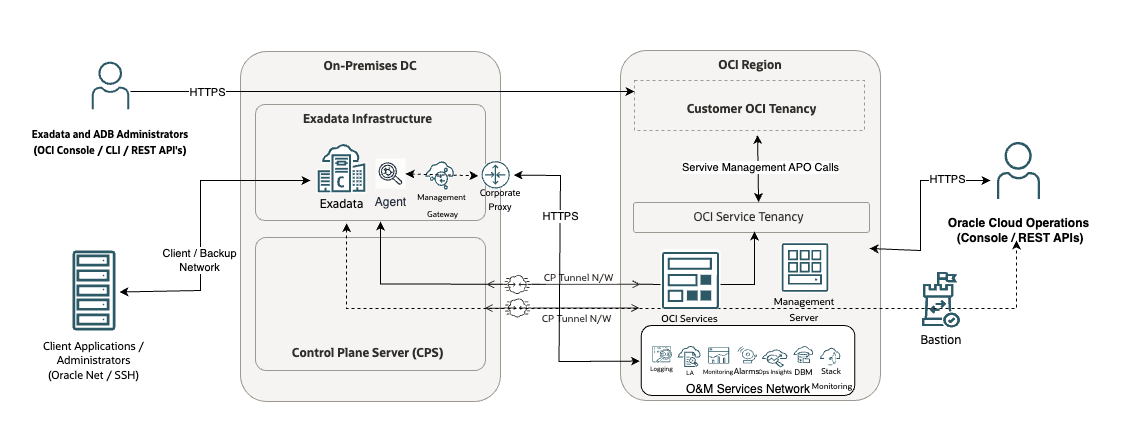
Prerequisites before implementing OCI Obervability and Management on Exadata Cloud@Customer
- Exadata Database services on Cloud@Customer require the cluster to be discovered on OCI to enable the native database services discovery support.
- Exadata monitoring on O&M requires communication between Management Agents on Exadata Cloud VM servers and OCI. Refer to this article to enable secure communication between the Exadata infrastructure and OCI.
- To learn about the Management Agent Cloud Service and complete the tenancy configuration prerequisites for management agent installation, refer to Perform Prerequisites for Deploying Management Agents.
- Install only the ZIP version of the management agent. Refer to these installation instructions for more details.
- Deploy the Management Gateway to enable secure communication between the management agent and OCI O&M services.
- If your organization has a corporate proxy, configure the management gateway to connect via the proxy. Refer to the gateway documentation for more details.
- Refer to Oracle Doc ID. 3015115.1 for more details about the management agent validation instructions and considerations.
OCI Observability and Management Services supported on Exadata infrastructure
VM clusters, virtual machines, and database targets running on the Exadata infrastructure can be discovered on O&M services. The following services are supported by this solution.
- Database Management
- Ops Insights
- Logging Analytics
- Stack Monitoring
Database Management
To enable database management on Exadata Cloud@Customer, select the managed databases from Database Administration and select the database type as Exadata Database service on Cloud@Customer. Once the VM Cluster is selected, the DB Home and the respective database details will be populated. Select the PDB to enable Database Management for PDBs also.
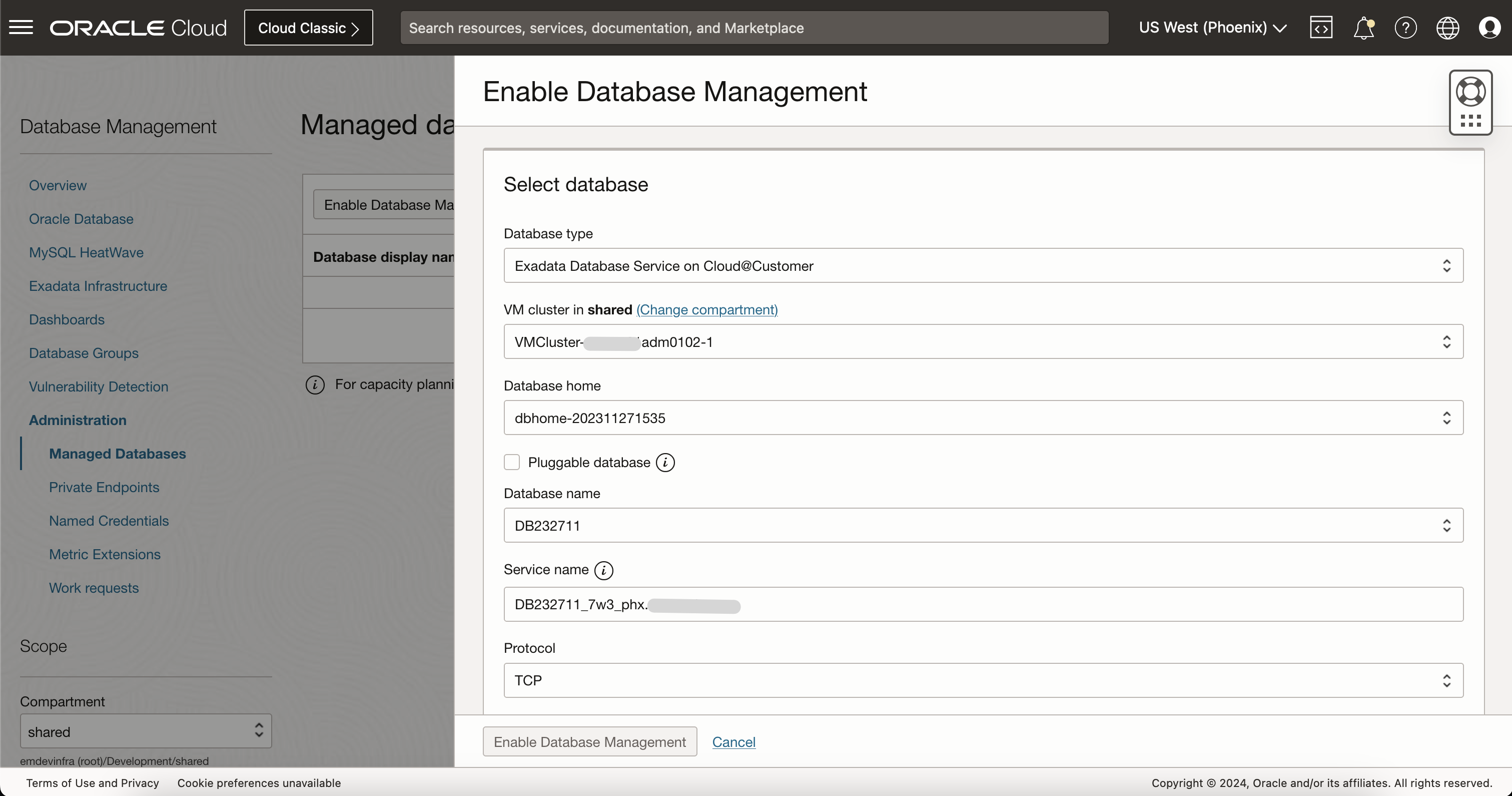
In addition, choose the Management Agent and select the management option as “Full management”.
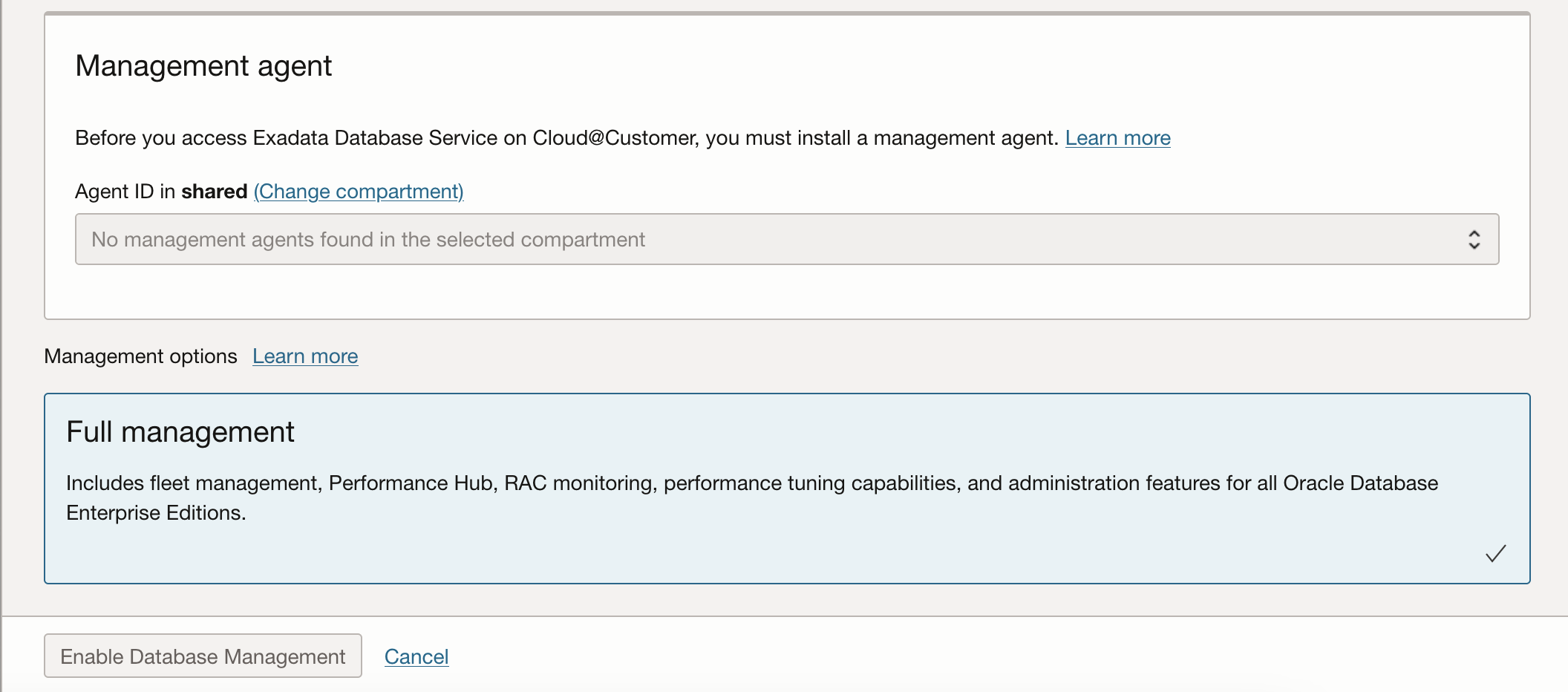
Follow the External Database option to discover the normal Exadata Infrastructure.
Ops Insights – ExaCC Discovery
Exadata Database Services on Cloud@Customer Services can be discovered directly in Ops Insights, enabling users to gain insight into Capacity Planning and SQL Insights.
For Discovering the ExaCC Targets, refer to this documentation. Refer to this blog for more details about this feature.
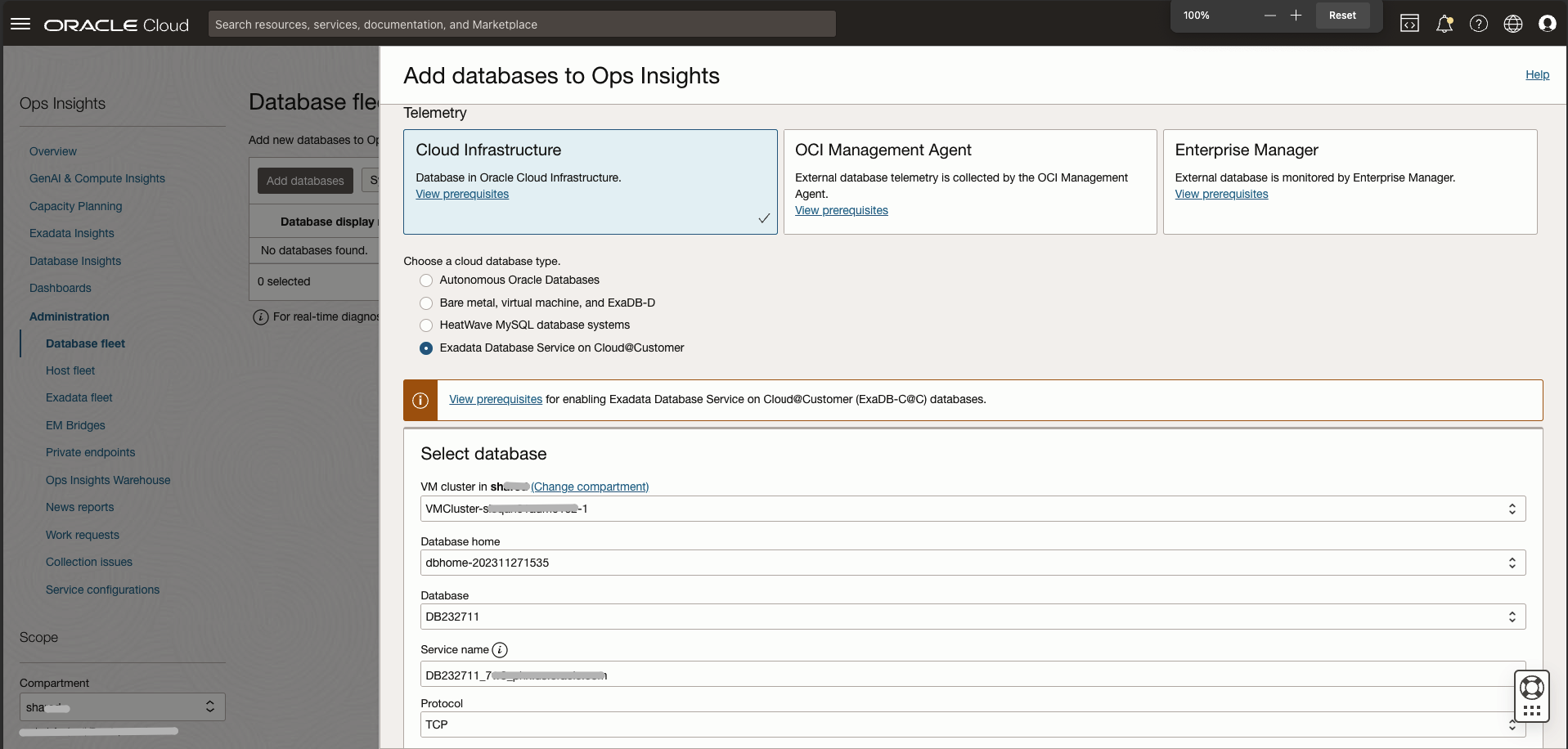
Ops Insights – Hosts
To add Exadata host targets to Ops Insights Host Capacity Planning, refer to Enable Host for the Service.
This discovery procedure is similar to the regular on-premises host targets.
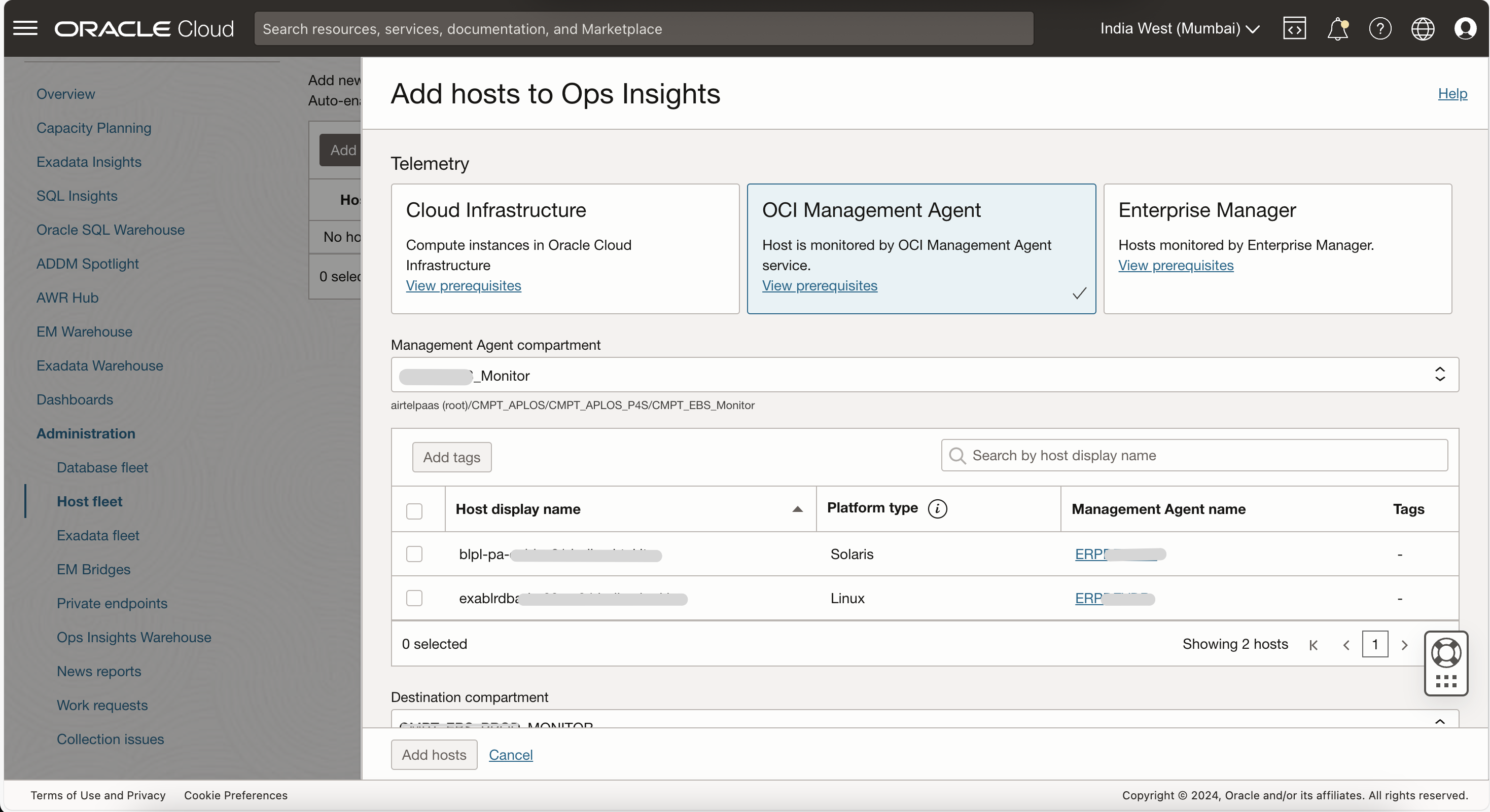
Logging Analytics
OCI provides a comprehensive Logging Analytics solution designed to work seamlessly with Exadata systems. This solution helps to monitor, analyze, and manage log data generated by Exadata environments. Below are the steps to discover Exadata systems in Logging Analytics, after setting up the management agent:
- Identify the log sources.
- Create the Entities.
- Create the log Group.
- Set up Log parsers.
- Configure Dashboards.
- Create Alerts and Notifications.
Logs supported on Exadata Systems:
- Database logs
- Host logs
- Storage logs
- Network logs
- Clusterware logs
- Exawatcher logs
- Backup and Recovery logs, and so on.
- Refer to OCI Logging Analytics Best Practices Series – Custom Log Sources and Parsers Tips blog for best practices on custom log sources and parsers.
- Refer to Monitoring Exadata Database Machines with OCI Logging Analytics blog for more details on configuring Exawatcher logs.
- Refer to Logging Analytics discovery process documentation.
OCI Stack Monitoring monitors the Exadata Infrastructure host, database, and applications
OCI Stack Monitoring enables monitoring of the host, database and the applications associated with the Exadata Infrastructure. It helps consolidate resources discovered from different telemetries and monitors them in a single window pane. OCI Stack Monitoring offers the discovery of these resources:
- Oracle Database CDB / PDB running on Exadata
- Exadata hosts
- Applications associated with Exadata Infrastructure.
Refer to the Stack Monitoring documentation for more details on the discovery process and supported infrastructure.
Get started today!
OCI O&M services for Exadata infrastructure empower businesses to achieve the best of both worlds by combining the robust capabilities of Exadata with the agility and efficiency of cloud management. This solution is ideal for organizations seeking to modernize their IT infrastructure, enhance their database performance, and maintain control over the database environments in a hybrid and multi cloud scenario.
Check out the Livelabs to learn more about the Exadata Cloud@Customer solution. Not yet a customer? Sign up for an Oracle Cloud Infrastructure trial account!
